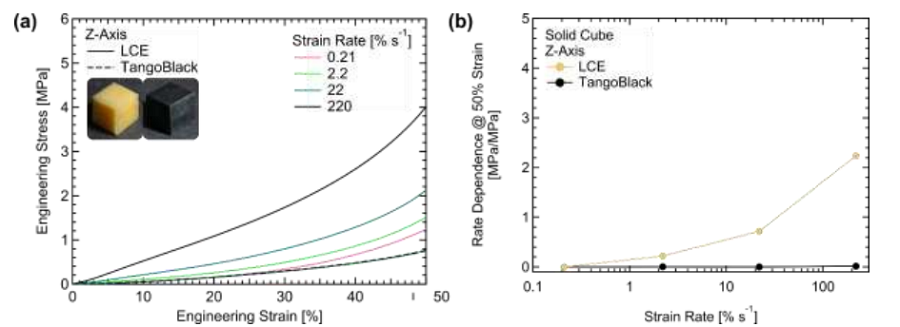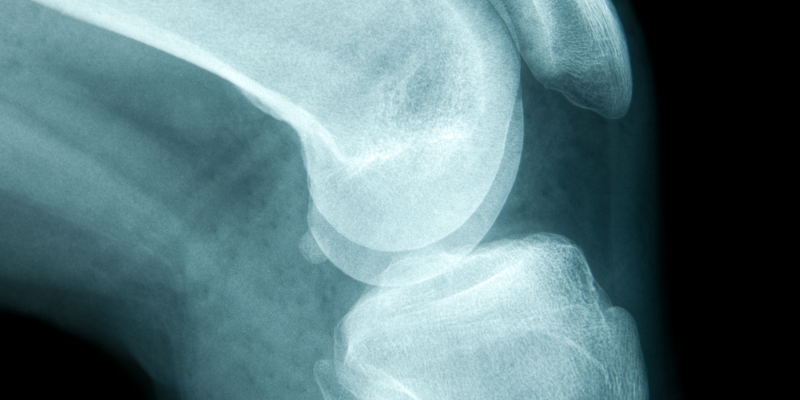Biological tissues are amazing materials. Over the years, our biological tissues mature and change so they can provide exactly what’s needed for their individual function, like how elastic cartilage can resist compression but cushion our joints at the same time. As mere mortals, it’s tough to fabricate synthetic replacements that mimic what our biological tissues are capable of, but 3D printing can help. A team of scientists from University of Colorado Denver (CU Denver) have succeeded in creating a 3D printing material that can replicate the properties of human tissue, and published their results in a paper titled “Liquid‐Crystal‐Elastomer‐Based Dissipative Structures by Digital Light Processing 3D Printing.”
The key to their success is liquid crystal elastomers, or LCEs:
“Digital Light Processing (DLP) 3D printing enables the creation of hierarchical complex structures with specific micro‐ and macroscopic architectures that are impossible to achieve through traditional manufacturing methods,” the abstract states. “Here, this hierarchy is extended to the mesoscopic length scale for optimized devices that dissipate mechanical energy. A photocurable, thus DLP‐printable main‐chain liquid crystal elastomer (LCE) resin is reported and used to print a variety of complex, high‐resolution energy‐dissipative devices. Using compressive mechanical testing, the stress–strain responses of 3D‐printed LCE lattice structures are shown to have 12 times greater rate‐dependence and up to 27 times greater strain–energy dissipation compared to those printed from a commercially available photocurable elastomer resin. The reported behaviors of these structures provide further insight into the much‐overlooked energy‐dissipation properties of LCEs and can inspire the development of high‐energy‐absorbing device applications.”
The team is led by CU Denver mechanical engineer professor Chris Yakacki, PhD, and includes doctoral student Nicholas Traugutt; postdoctoral fellow Devesh Mistry, PhD; Chaoqian Luo; professor Kai Yu, PhD; and Qi Ge with the Southern University of Science and Technology in China. These scientists are reportedly the first to use LCEs to 3D print complex, porous lattice structures, which can be used to build synthetic devices that mimic biological tissues, like cartilage.
“Everyone’s heard of liquid crystals because you stare at them in your phone display. And you’ve likely heard of liquid crystal polymers because that’s exactly what Kevlar is,” explained Yakacki. “Our challenge was to get them into soft polymers, like elastomers, to use them as shock absorbers. That’s when you go down the layers of complexity.”
It’s tough to manipulate multifunctional LCEs, which are soft, elastic materials that can dissipate high energy really well. In the past, researchers could only use LCEs to make nearly microscopic structures with high detail, or larger objects with low detail. But what the world really needs are big devices with high resolution and detail, which is now finally possible thanks to the CU Denver team.
Yakacki works in the university’s Smart Materials and Biomechanics (SMAB) Lab, and has worked with LCEs since 2012, even receiving an NSF CAREER award in 2018 to transform how manufacturable LCEs are, along with multiple funding rounds to develop the material into a football helmet shock absorber. For this research, which was supported by the Laboratory Directed Research and Development program at Sandia National Laboratories, the US Army Research Laboratory, and US Army Research Office, the team used digital light processing (DLP) technology.

The motivation: dissipation controlled across length scales from the resin chemistry (mesoscale), to the microscale lattice architecture, and the overall macrostructure of printed structures.
They created a liquid crystal resin, similar to honey, that generates new bonds in the form of photopolymer layers when cured with ultraviolet light. The cured resin creates a compliant elastomer that’s both soft and strong, and begins to mimic cartilage when it’s 3D printed in a lattice structure.
“Compressive stress-strain testing identified several advantages that DLP 3D-printed LCEs have compared to traditional elastomers. First, print orientation does not significantly influence mechanical properties of solid structures, seen by the isotropic properties of the solid LCE structure,” the researchers wrote. “Our LCE resin was designed to be manufactured and used within 24 hours; therefore, it does not have added inhibitors to provide longer shelf life. Photoabsorptive dye is used minimally to prevent over-curing during printing, not color.”

(a) Representative DSC plot of a DLP printed LCE. Images of a printed lotus flower sample in nematic and isotropic states are shown on respective sides relative to Ti on the curve. (b) Representative DMA plots of the DLP printed LCE and TangoBlack sample showing loss and storage modulus, as well as the loss ratio (tan δ).
Using their resin and a custom DLP printer, the team 3D printed multiple structures, such as a small lotus flower and a spinal fusion cage prototype, both of which had plenty of detail. Additionally, combining DLP printing and the resin resulted in a rate-dependence that was 12 times greater, and a strain-energy dissipation up to 27 times greater, in comparison to structures 3D printed out of Tango Black Plus, a commercially available photocurable elastomer resin.

(a) DLP printed LCE and TangoBlack solid cube structures were tested under uniaxial compressive loading and stress responses were observed. (b) Stress values at 50% strain were observed to quantify rate-dependence for the two materials.
In addition to shock-absorbing football helmets, these DLP printed LCE structures could have many other applications as well, such as small biomedical implants for toes and spinal devices.
“The spine is full of challenges and it’s a hard problem to solve. People have tried making synthetic spinal tissue discs and they haven’t done a good job of it,” Yakacki said. “With 3D printing, and the high resolution we’ve gotten from it, you can match a person’s anatomy exactly. One day, we may be able to grow cells to fix the spine, but for now, we can take a step forward with the next generation of materials. That’s where we’d like to go.”
Discuss this and other 3D printing topics at 3DPrintBoard.com or share your thoughts below.
(Source: Lab Manager / Images: University of Colorado Denver)
Subscribe to Our Email Newsletter
Stay up-to-date on all the latest news from the 3D printing industry and receive information and offers from third party vendors.
You May Also Like
IperionX Inks 10-Year Deal with Wisconsin Manufacturer for 80 Metric Tons of Titanium Per Year
IperionX, the Charlotte-based supplier of sustainable titanium powders used for additive manufacturing (AM) and metal injection molding (MIM), has signed a ten-year deal with United Stars, a group of industrial...
Gastronology Launches Industrial Production of 3D Printed Food for Dysphagia Patients
Food 3D printing has, in many ways, been an additive manufacturing (AM) segment looking for the right business case. While some applications are beautiful and others may or may not...
Lockheed Martin Leads $3M Investment in Q5D’s Electronics 3D Printing System
Q5D, an original equipment manufacturer (OEM) of robotic arm, hybrid additive manufacturing (AM) systems used for wire harness production, has closed a $3 million investment round. The investment arm of...
3D Printing News Briefs, April 6, 2024: Depowdering, Cybertruck Door Handles, & More
In today’s 3D Printing News Briefs, ioTech’s digital manufacturing CLAD technology is opening up opportunities for microelectronics and additive manufacturing. Hexagon and Raytheon Technologies commercially released the Simufact Additive Process...
































